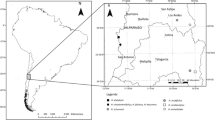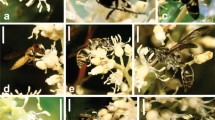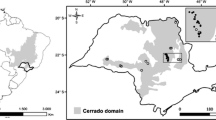Abstract
Parasitoid wasps occur in diverse communities, with the adults of most species sourcing carbohydrates from nectar or honeydew. However, the role of niche partitioning of nectar resources in maintaining diverse communities of parasitoid Hymenoptera is poorly known. To elucidate patterns of nectar resource use and test whether species partition resources, we investigated pollen loads in a community of parasitoid thynnine wasps in the biodiversity hotspot of southwestern Australia. In total, 304 thynnine wasps from 28 species were captured. Eighteen of these species are undescribed, highlighting the high diversity of unrecognized species in southwestern Australia. Pollen loads were detected on 111 individuals representing 19 species. Six pollen types were identified. All species that carried pollen primarily visited two tree species, Agonis flexuosa and Eucalyptus marginata, in the Myrtaceae. The other four pollen types were only recorded from single wasps. There was no evidence of nectar-resource partitioning. This may be due to these Myrtaceae producing abundant, open-faced flowers. Wasp species that were not recorded carrying pollen may utilise other carbohydrate sources, such as homopoteran honeydew. Niche partitioning is predicted to occur during the parasitoid larval phase of the life cycle. This study highlights the importance of nectariferous Myrtaceae in supporting diverse wasp communities. Further, two species of nectar-foraging wasps collected here are involved in the pollination of rare orchid species. Hence, conservation and management of habitats that support floriferous Myrtaceae are important for both the maintenance of diverse wasp communities, and the plants they pollinate.

Similar content being viewed by others
References
Alcock J (1981) Notes on the reproductive behavior of some Australian thynnine wasps (Hymenoptera: Tiphiidae). J Kansas Entomol Soc 54:681–693
Alcock J, Gwynne DT (1987) Courtship feeding and mate choice in thynnine wasps (Hymenoptera: Tiphiidae). Aust J Zool 35:451–458
Austin AD, Yeates DK, Cassis G, Fletcher MJ, La Salle J, Lawrence JF, McQuillan PB, Mound LA, Bickel DJ, Gullan PJ, Hales DF, Taylor GS (2004) Insects ‘Down Under’—diversity, endemism and evolution of the Australian insect fauna: examples from select orders. Aust J Entomol 43:216–234
Bailey R, Schönrogge K, Cook JM, Melika G, Csóka G, Thuróczy C, Stone GN (2009) Host niches and defensive extended phenotypes structure parasitoid wasp communities. PLoS Biol 7:e1000179. doi:10.1371/journal.pbio.1000179
Bascompte J, Jordano P (2007) Plant–animal mutualistic networks: the architecture of biodiversity. Annu Rev Ecol Evol Syst 38:567–593
Bascompte J, Jordano P, Olesen JM (2006) Asymmetric coevolutionary networks facilitate biodiversity maintenance. Science 312:431–433
Beil M, Horn H, Schwabe A (2008) Analysis of pollen loads in a wild bee community (Hymenoptera: Apidae)—a method for elucidating habitat use and foraging distances. Apidologie 39:456–467
Bernhardt P (1987) A comparison of the diversity, density, and foraging behavior of bees and wasps on Australian Acacia. Ann Mo Bot Gard 74:42–50
Bohman B, Phillips RD, Menz MHM, Berntsson BW, Flematti GR, Barrow RA, Dixon KW, Peakall R (2014) Discovery of pyrazines as pollinator sex pheromones and orchid semiochemicals: implications for the evolution of sexual deception. New Phytol 203:939–952
Bower CC (1996) Demonstration of pollinator-mediated reproductive isolation in sexually deceptive species if Chiloglottis (Orchidaceae: Caladeniinae). Aust J Bot 44:15–33
Brown GR (2009) Description of two pseudaposematic species with a review of defensive adaptations in the subfamily Thynninae (Hymenoptera: Thynnidae). Beagle (Darwin) 25:71–78
Brown GR, Phillips RD (2014) A review of the diet of flower wasps (Hymenoptera: Thynnidae: Thynninae). North Territ Nat 25:50–63
Brown AP, Thomson-Dans C, Marchant N (1998) Western Australia’s threatened flora. Department of Conservation and Land Management, Perth
Burrell RW (1935) Notes on the habits of certain Australian Thynnidae. J N Y Entomol Soc 43:19–29
Davis RA, Gole C, Roberts JD (2013) Impacts of urbanisation on the native avifauna of Perth, Western Australia. Urban Ecosyst 16:427–452
Department of Environment and Conservation (2008) Grand Spider Orchid (Caladenia huegelii) Interim Recovery Plan 2008–2013. Interim Recovery Plan No. 272. Department of Environment and Conservation, Western Australia
Gaskett AC (2011) Orchid pollination by sexual deception: pollinator perspectives. Biol Rev 86:33–75
Given BB (1954) Evolutionary trends in the Thynninae (Hymenoptera: Tiphiidae) with special reference to feeding habits of Australian species. Trans R Entomol Soc London 105:1–10
Greenleaf SS, Williams NM, Winfree R, Kremen C (2007) Bee foraging ranges and their relationship to body size. Oecologia 153:589–596
Griffiths KE, Trueman JWH, Brown GR, Peakall R (2011) Molecular genetic analysis and ecological evidence reveals multiple cryptic species among thynnine wasp pollinators of sexually deceptive orchids. Mol Phylogenet Evol 59:195–205
Hopper SD, Brown AP (2007) A revision of Australia’s hammer orchids (Drakaea: Orchidaceae), with some field data on species-specific sexually deceived wasp pollinators. Aust Syst Bot 20:252–285
How RA, Dell J (2000) Ground vertebrate fauna of Perth’s vegetation remnants: the impacts of 170 years of urbanization. Pac Conserv Biol 6:198–217
Janvier H (1933) Études biologiques de quelques Hymenoptères du Chili. Ann Sci Nat Zool 16:209–356
Jervis MA, Kidd NAC, Fitton MG, Huddleston T, Dawah HA (1993) Flower-visiting by hymenopteran parasitoids. J Nat Hist 27:67–105
Jervis MA, Ellers J, Harvey JA (2008) Resource acquisition, allocation, and utilization in parasitoid reproductive strategies. Annu Rev Entomol 53:361–385
Jha S, Stefanovich L, Kremen C (2013) Bumble bee pollen use and preference across spatial scales in human-altered landscapes. Ecol Entomol 38:570–579
Kearns CA, Inouye DW, Waser NM (1998) Endangered mutualisms: the conservation of plant-pollinator interactions. Annu Rev Ecol Syst 29:83–112
Keighery GJ (1975) Pollination of Hibbertia hypericoides (Dilleniaceae) and its evolutionary significance. J Nat Hist 9:681–684
LaSalle J, Gauld ID (1991) Parasitic Hymenoptera and the biodiversity crisis. Redia 74:315–334
Layman CA, Araujo MS, Boucek R, Hammerschlag-Peyer CM, Harrison E, Jud ZR, Matich P, Rosenblatt AE, Vaudo JJ, Yeager LA, Post DM, Bearhop S (2012) Applying stable isotopes to examine food-web structure: an overview of analytical tools. Biol Rev 87:545–562
Levine JM, HilleRisLambers J (2009) The importance of niches for the maintenance of species diversity. Nature 461:254–257
MacArthur RH (1958) Population ecology of some warblers of northeastern coniferous forests. Ecology 39:599–619
MacArthur RH, MacArthur JW (1961) On bird species diversity. Ecology 42:594–598
Menz MHM, Phillips RD, Winfree R, Kremen C, Aizen MA, Johnson SD, Dixon KW (2011) Reconnecting plants and pollinators: challenges in the restoration of pollination mutualisms. Trends Plant Sci 16:4–12
Menz MHM, Phillips RD, Dixon KW, Peakall R, Didham RK (2013) Mate-searching behaviour of common and rare wasps and the implications for pollen movement of the sexually deceptive wasps they pollinate. PLoS One 8:e59111. doi:10.1371/journal.pone.0059111
Menz MHM, Phillips RD, Anthony JM, Bohman B, Dixon KW, Peakall R (2015) Ecological and genetic evidence for cryptic ecotypes in a rare sexually deceptive orchid, Drakaea elastica. Bot J Linn Soc 177:124–140
Paulus HF, Gack C (1990) Pollinators as prepollinating isolation factors: evolution and speciation in Ophrys (Orchidaceae). Israel J Bot 39:43–79
Pauw A, Hawkins JA (2011) Reconstruction of historical pollination rates reveals linked declines of pollinators and plants. Oikos 120:344–349
Peakall R (1990) Responses of male Zaspilothynnus trilobatus Turner wasps to females and the sexually deceptive orchid it pollinates. Funct Ecol 4:159–167
Peakall R, Smouse PE (2006) GENALEX 6: genetic analysis in Excel Population genetic software for teaching and research. Mol Ecol Notes 6:288–295
Peakall R, Smouse PE (2012) GenAlEx 6.5: genetic analysis in Excel. Population genetic software for teaching and research—an update. Bioinformatics 28:2537–2539
Peakall R, Ebert D, Poldy J, Barrow RA, Francke W, Bower CC, Schiestl FP (2010) Pollinator specificity, floral odour chemistry and the phylogeny of Australian sexually deceptive Chiloglottis orchids: implications for pollinator-driven speciation. New Phytol 188:437–450
Phillips RD, Faast R, Bower CC, Brown GR, Peakall R (2009) Implications of pollination by food and sexual deception for pollinator specificity, fruit set, population genetics and conservation of Caladenia (Orchidaceae). Aust J Bot 57:287–306
Phillips RD, Brown AP, Hopper SD, Dixon KW (2011) Orchid biogeography and factors associated with rarity in a biodiversity hotspot, the Southwest Australian Floristic Region. J Biogeogr 38:487–501
Phillips RD, Peakall R, Hutchinson MF, Linde CC, Xu T, Dixon KW, Hopper SD (2014) Specialized ecological interactions and plant species rarity: the role of pollinators and mycorrhizal fungi across multiple spatial scales. Biol Conserv 169:285–295
Pianka ER (1973) The structure of lizard communities. Annu Rev Ecol Syst 4:53–74
R Core Team (2014) R: a language and environment for statistical computing. R Foundation for Statistical Computing, Vienna, Austria. http://www.R-project.org/
Ridsdill-Smith TJ (1970a) The behaviour of Hemithynnus hyalinatus (Hymenoptera: Tiphiidae), with notes on some other Thynninae. J Aust Entomol Soc 9:196–208
Ridsdill-Smith TJ (1970b) The biology of Hemithynnus hyalinatus (Hymenoptera: Tiphiidae), a parasite on scarabeid larvae. J Aust Entomol Soc 9:183–195
Ridsdill-Smith TJ (1971) Field notes on the occurrence of Hemithynnus hyalinatus (Hymenoptera: Tiphiidae) as a parasite of scarabeids on the New England Tablelands. J Aust Entomol Soc 10:265–270
Schiestl FP, Peakall R, Mant JG, Ibarra F, Schulz C, Francke S, Francke W (2003) The chemistry of sexual deception in an orchid-wasp pollination system. Science 302:437–438
Smith AM, Rodriguez JJ, Whitfield JB, Deans AR, Janzen DH, Hallwachs W, Hebert PDN (2008) Extreme diversity of tropical parasitoid wasps exposed by iterative integration of natural history, DNA barcoding, morphology, and collections. Proc Natl Acad Sci USA 105:12359–12364
Stoutamire WP (1974) Australian terrestrial orchids, thynnid wasps, and pseudocopulation. Am Orchid Soc Bull 43:13–18
Stoutamire WP (1983) Wasp-pollinated Species of Caladenia (Orchidaceae) in South-western Australia. Aust J Bot 31:383–394
Tomlinson S, Mathialagan PD, Maloney SK (2014) Special K: testing the potassium link between radioactive rubidium (86Rb) turnover and metabolic rate. J Exp Biol 217:1040–1045
Vázquez DP, Aizen MA (2004) Asymmetric specialization: a pervasive feature of plant–pollinator interactions. Ecology 85:1251–1257
Veijalainen A, Wahlberg N, Broad GR, Erwin TL, Longino JT, Sääksjärvi IE (2012) Unprecedented ichneumonid parasitoid wasp diversity in tropical forests. Proc R Soc B 279:4694–4698
Veijalainen A, Sääksjärvi IE, Tuomisto H, Broad GR, Bordera S, Jussila R (2014) Altitudinal trends in species richness and diversity of Mesoamerican parasitoid wasps (Hymenoptera: Ichneumonidae). Insect Conserv Divers 7:496–507
Wäckers FL (2004) Assessing the suitability of flowering herbs as parasitoid food sources: flower attractiveness and nectar accessibility. Biol Control 29:307–314
Wooller RD, Russell EM, Renfree MB (1983) A technique for sampling pollen carried by vertebrates. Aust Wildlife Res 10:433–434
Yates CJ, Hopper SD, Taplin RH (2005) Native insect flower visitor diversity and feral honeybees on jarrah (Eucalyptus marginata) in Kings Park, an urban bushland remnant. J R Soc West Aust 88:147–153
Acknowledgments
Funding was provided by Jandakot Airport Holdings and an Australian Research Council linkage grant (LP110100408) to KWD and Rod Peakall. The fieldwork was also supported by a grant from the Holsworth Wildlife Research Endowment awarded to MHMM. Special thanks to Ms. E. David for field and laboratory assistance.
Author information
Authors and Affiliations
Corresponding author
Electronic supplementary material
Below is the link to the electronic supplementary material.
Rights and permissions
About this article
Cite this article
Menz, M.H.M., Brown, G.R., Dixon, K.W. et al. Absence of nectar resource partitioning in a community of parasitoid wasps. J Insect Conserv 19, 703–711 (2015). https://doi.org/10.1007/s10841-015-9793-2
Received:
Accepted:
Published:
Issue Date:
DOI: https://doi.org/10.1007/s10841-015-9793-2




